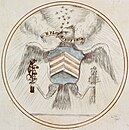Novus ordo seclorum

The phrase Novus ordo seclorum (English: /ˈnoʊvəs ˈɔːrdoʊ sɛˈklɔːrəm/, Latin: [ˈnɔwʊs ˈoːrdoː seːˈkloːrũː]; "New order of the ages") is one of two Latin mottos on the reverse side of the Great Seal of the United States. The other motto is Annuit cœptis. The mottos were coined by Charles Thomson, the secretary of the Congress of the Confederation.[1][2]
Thomson derived the phrase Novus ordo seclorum from a poem by the Roman poet Virgil. He wrote that the phrase signified "the beginning of the New American Era" as of the date of the Declaration of Independence in 1776, which was depicted in Roman numerals at the base of the pyramid on the seal.[1][2]
Origin
[edit]The phrase derives from the fourth poem of the Eclogues by the Latin poet Virgil.[3] The fourth eclogue contains the passage (lines 4–10):[4][5]
Ultima Cumaei venit iam carminis aetas: |
Now is come the last age of the Cumaean prophecy: |
The motto is specifically a rephrasing of the second line: "Magnus ab integro saeclorum nascitur ordo" (The great cycle of ages is born anew).[3]
Meaning
[edit]The forms saecla, saeclorum etc. were normal alternatives to the more common saecula etc. throughout the history of Latin poetry and prose. The form saeculorum is impossible in hexameter verse: the ae and o are long, the u short by position.
The word seclorum does not mean "secular", but is the genitive (possessive) plural form of the word saeculum, meaning (in this context) generation, century, or age. Saeculum did come to mean "age, world" in late, Christian Latin, and "secular" is derived from it, through secularis. However, the adjective "secularis," meaning "worldly," is not equivalent to the genitive plural "seclorum," meaning "of the ages."[6]
The motto Novus ordo seclorum was translated and added to the seal by Charles Thomson, a Latin expert who was involved in the design of the Great Seal, as "A new order of the ages." Thomson said it was to signify "the beginning of the new American Era" as of the date of the Declaration of Independence in 1776, which was depicted in Roman numerals at the base of the pyramid on the seal.[1][2]
See also
[edit]References
[edit]- ^ a b c "The Great Seal of the United States," U.S. Dept. of State, Bureau of Public Affairs, Washington, D.C., July 2003, pp. 4, 5, 15. PDF of official brochure.
- ^ a b c "Novus Ordo Seclorum - Origin and Meaning of the Motto Beneath the American Pyramid". GreatSeal.com.
- ^ a b United States. Dept. of State; Hunt, Gaillard (1909). The history of the seal of the United States. Harold B. Lee Library. Washington, D. C., Department of state. p. 34.
- ^ P. Vergilius Maro, Eclogues, J. B. Greenough, Ed.
- ^ Virgil; Mackail, J. W. (1910). The Eclogues and Georgics of Virgil. London: Longmans, Green, and co. p. 14.
- ^ Lewis and Short, A Latin Dictionary: Founded on Andrews' Edition of Freund's Latin Dictionary: Revised, Enlarged, and in Great Part Rewritten by Charlton T. Lewis, Ph.D. and Charles Short, LL.D. The Clarendon Press, Oxford, 1879, s. vv.

